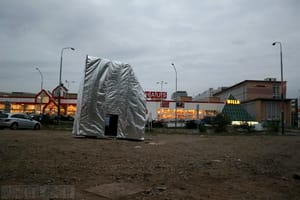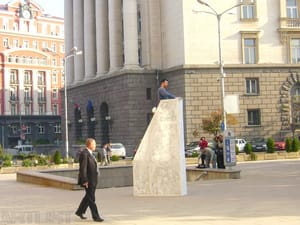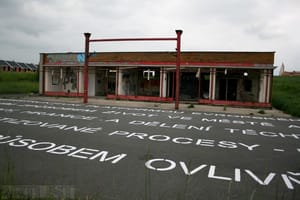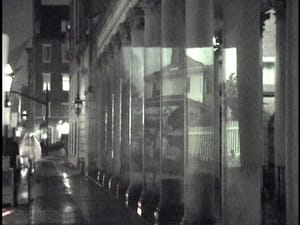- First Name
- Jan
- Surname
- Fabián
- Born
- 1978
- Birth place
- České Budějovice
- Place of work
- Prague
- Website
- www.janfabian.com
- CSU Library
- ↳ Find in the catalogue
About artist
“With respect to spatial objects I’m interested in the question of spaces and partial spaces and their complete vanishing not only “into space” but also “in time”...” (Jan Fabián, 2014)
In his art he utilizes the ethical function of each piece of his work, and through his individual projects he leads to contemplation over automated processes or he brings attention to the unbalanced relationships towards the environment. His works include spatial art, architecture, design and digital picture. His economical installations, objects and interiors give the impression of equilibrium and refreshing of the mind. He bases his work on his observations of reality and, at the same time, he belongs among the permanent searchers of meanings without the unnecessary burden of tragedy.
Many of his projects treat ecological unsustainability. This topic is most often present in his installations. This includes his gentle intervention in public space in 2008 when he placed a Statue of compost in a city park. He used a telephone booth as a compost bin and he filled it with bio garbage. It was possible to observe the individual layers of decomposition through the glass. This natural process appeared to be unsuitable for the city environment, although it was a positive act – recycling of an old telephone booth and the green waste from the park. Another piece of work with an ecological vertone was his performance the Sculpture of Traffic Jam, which he organized in 2009 in Prague in the gateway to the Školská Gallery. He invited several car owners to fill the entry to the courtyard and simulated a real traffic jam including the running of engines. He elaborated a wider social appeal in his project Good Times Are Over (2008). This performance took place at a parking lot in Prague at Pankrác with newly built high-rises and a hypermarket with construction material in the background. A strange little house made from aluminium steam-tight foil was groped along the parking lot. The situation looked like a strange parade with only one mask, which generated many questions and at the same time it was supposed to point out “(...) irreversible processes, which are decided by an immediate need instead of a long-term consideration.” (Jan Fabián, 2008). Part of the video performance was unpretentious humour when the movement of the house was dependant on the movement of a car concealed inside. Jan Fabián processed the exterior visual impulses in his photographic cycles. In his collection of photographs entitled Oversize (2009+) he documented movement of people through public space carrying unproportionally large objects, or in his Folder Without Title (2009) he pursued the capturing of small logical discrepancies that we are surrounded by every day. In his project 81 x 25 dpi (installation for the Czech Centre in London, UK, 2003) he re-evaluated the relationship between the real and the virtual. He blew up a photograph from the Internet so that its dimensions corresponded to reality on the scale of 1:1. He utilizes the results of his long-term observations when he works on interiors. The bright yellow that he used in building a garden gazebo on the inner window frames cannot be perceived as an empty aesthetical element in his case, but as a natural lighting up transfer between the gazebo and the garden, which is based on the colour of spring green leaves. In his sculpting work, he utilizes literal meanings as a certain form of downplaying the renewal of the profession, which was (perhaps still is a little) often revealed in the title – Statue of Traffic Jam (2009), Statue of Gallows (2001), Muscle Armchair (2002), Statue of Compost (2008), etc.
He fluently shifts between visual and applied arts without either part exceeding the other. One of his most liberal projects is probably The Hermitage in Kohoutov (2011), which is a tower like study made from sticks and beams in space. Jan Fabián continuously works in a very discreet way, which makes it that much more enjoyable to gradually discover his individual projects.
- Author of the annotation
- Denisa Bytelová
- Published
- 2014
CV
Studies:
1997-2003 Academy of Arts, Architecture and Design in Prague, Czech Republic
Stipends:
2001 Residency, Rhode Island School of Design, Glass Studio of Bruce Chao, Providence, USA
2000 Residency, Hammenlinna Polytechnic, Glass Studio of A. Tammisto, Finland
Employment:
2005-2007 Senior Lecturer – teaching sculpture at Faculty of Architecture. Czech Technical University in Prague.
2004-2006 Assistant of artist Karen LaMonte in Prague Studio.
Awards:
2003 1st prize First Art Biennial of European Students, Rome, Italy
1999 1st prize Nadace Romualdo del Bianco, Florencie, Italy
Exhibitions
- Solo exhibitions
-
2010
Model Situations, Galerie mladych, BKC Brno
2009
Good times has been over II. Gallery Skolska 28, Prague
2008
Good times has been over, performance, Prague
857m2, Abandoned Gasoline station near Slany, Czech Rebublic
2006
The Tin, Ceske Budejovice, Czech Republic
2004
Jan Fabian – Projects, Faculty of Architecture University of Technology Brno, Czech Republic
Pay Attention, Dog, dog shelter in Komorany, Prague, Czech Republic
2003
The Synagogue Folder, Palmovka, Praha, Czech Republic
2001
Site Specific Installation, Trenton St. no.18, Providence, U.S.A
Site Specific Video Installation, Benefit St.,Providence, U.S.A
2000
The Stripes, Hameenlinna Polytechnic, Finland
- Group exhibitions not included in ARTLIST.
-
2009
Telescopic Studio, Vaclav Spala Gallery, Prague
Aktualizacja.cz, Further Reading, Muzeum Witrazu, Krakow
Underground City, Divus Unit 30, London
Second Shift, Armaturka, Usti nad Labem, Czech Republic
Kompot, Theatre Usti nad Labem, Czech Republic
Design Story, Mobitex Brno, Czech Republic
2008
Season, Gallery AAAD Prague
Kotec, Usti nad Labem, Czech Republic
Big Action Painting Show, 4 Days in Motion, Hoelesovice, Prague
Low Budget Revolution – Cargo, Sofia, Bulgaria
Art phone, Park Kampa, Prague
Construction Limits, with Ondrej Horak and Isabela Grosseova
Centrum současného umění Ládví, NOD, Prague
2007
Czech, Czech Centre, Peking, China
2005
Czech This Out! Viena, Austria
Date Of Expire, Designblok, Karlin Hall, Prague, Czech Republic
Enter, Jesuit Dormitory of Palacky, Olomouc, Czech Republic
RISD-VŠUP, Gallery AAAD Prague, Czech Republic
2004
Nothing For Show, Katerinska Garden, Prague, Czech Republic
Milky Way Confrontation, Designblok, Belveder Prague Castle, Czech Republic
Funeral Art, National Gallery, Prague, Czech Republic
2003
First Art Biennial of European Students Complesso Monumentale di S. Michele, Rome, Italy
New Media Cheb 2003, Cheb Czech Republic
Diploma Art Works, Gallery AAAD Prague
The TV Set Kulas, Lucany nad Nisou, Czech Republic
The Potential Connection, Czech Centre, London, Sunderland, Great Britain
2002
Orrefors workshop, Orrefors, Sweden
2001
Nova Media Cheb 2001, Cheb, Czech Republic
2000
Budky, 1. socharske bienale, Zdar nad Sazavou, Czech Republic
Identity workshop, Louka monastery, Znojmo, Czech Republic
Komunikace, Galerie pod vezi Bilina, Czech Republic
1999
Orrefors workshop, Orrefors, Sweden
- Collections
-
Museum of Applied Arts Prague, Czech Republic
Compleso Monumentale del San Michele, Rome, Italy
Monography
- Monography
Vomacka Josef. Recenze: Dobre uz bylo / a nekdo to vnima. CT24, 20.2. 2009
Vojtechovský Milos, Statistic and Art, Text Gallery Skolska 28 12. 2. 2009
The Year Book of Czech Design, Czech Grand Design 2008 Awards page. 28
New Glass Review 28, Corning Museum of Glass, Published 2007 page. 112
Fabian, Jan. Katedra volneho umeni VSUP, Autorský text Korpus no.3 June/2004 page 24–25
Hlaves, Milan. Fakulta architektury VUT Brno. Atelier 1/2005 page 5, Rec. Vystavy:Jan Fabian–Projekty“ 2.11.–30.11. 2004
Lindaurova, Lenka. Neobvykla vystava: neviditelne objekty v zahrade. Mlada Fronta Dnes 30.10. 2004
Macek, Jiri. Loft Look, Blok no.15, 2006 page 64–67
McGuirk, Justin. Design Sities: Prague. [Rec. vystavy] ICON 12/2004 page 68
Pauly, Jana. Pripraveny prostor, First Art Biennial of the European Students , Atelier 1/2004









